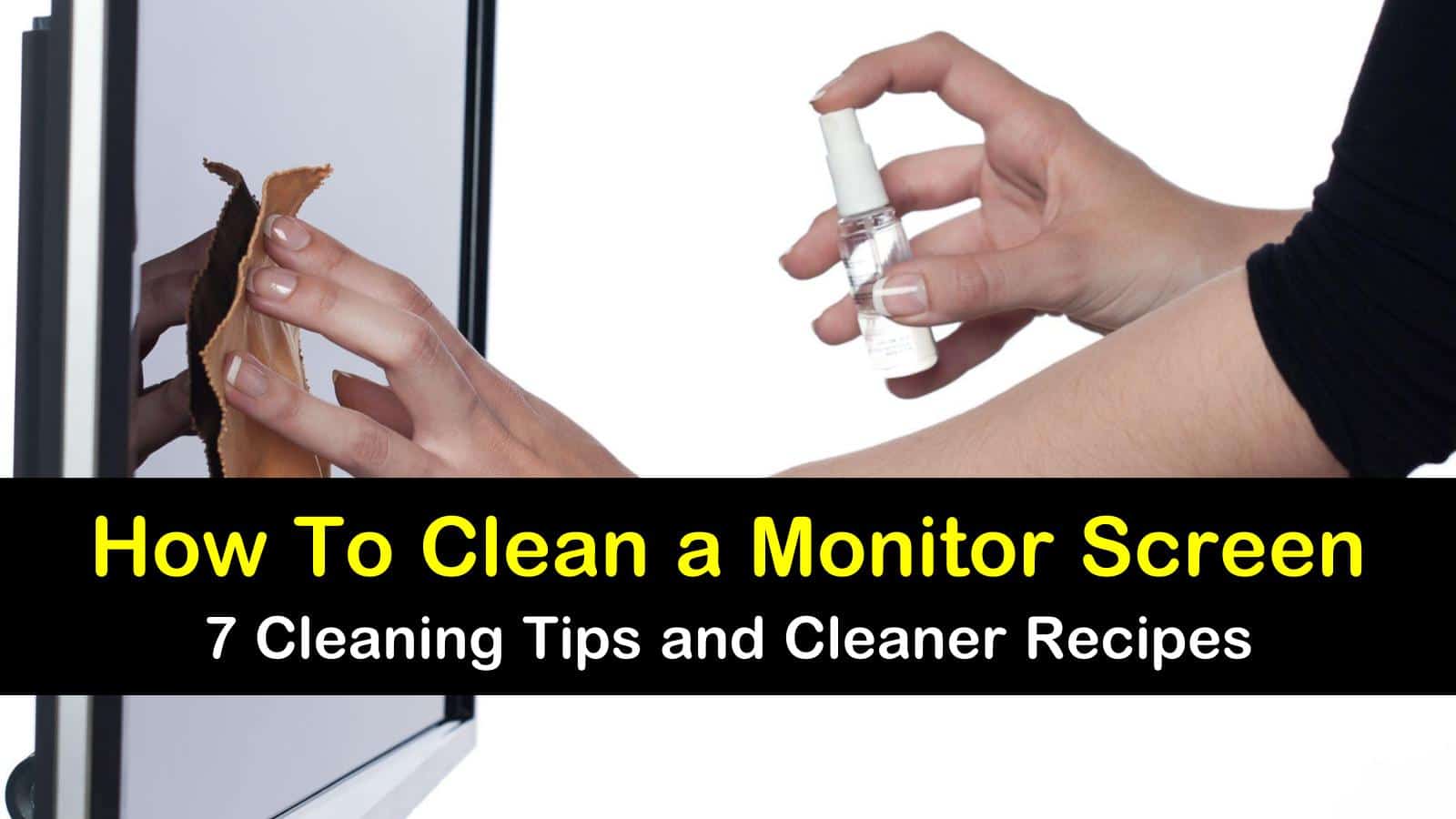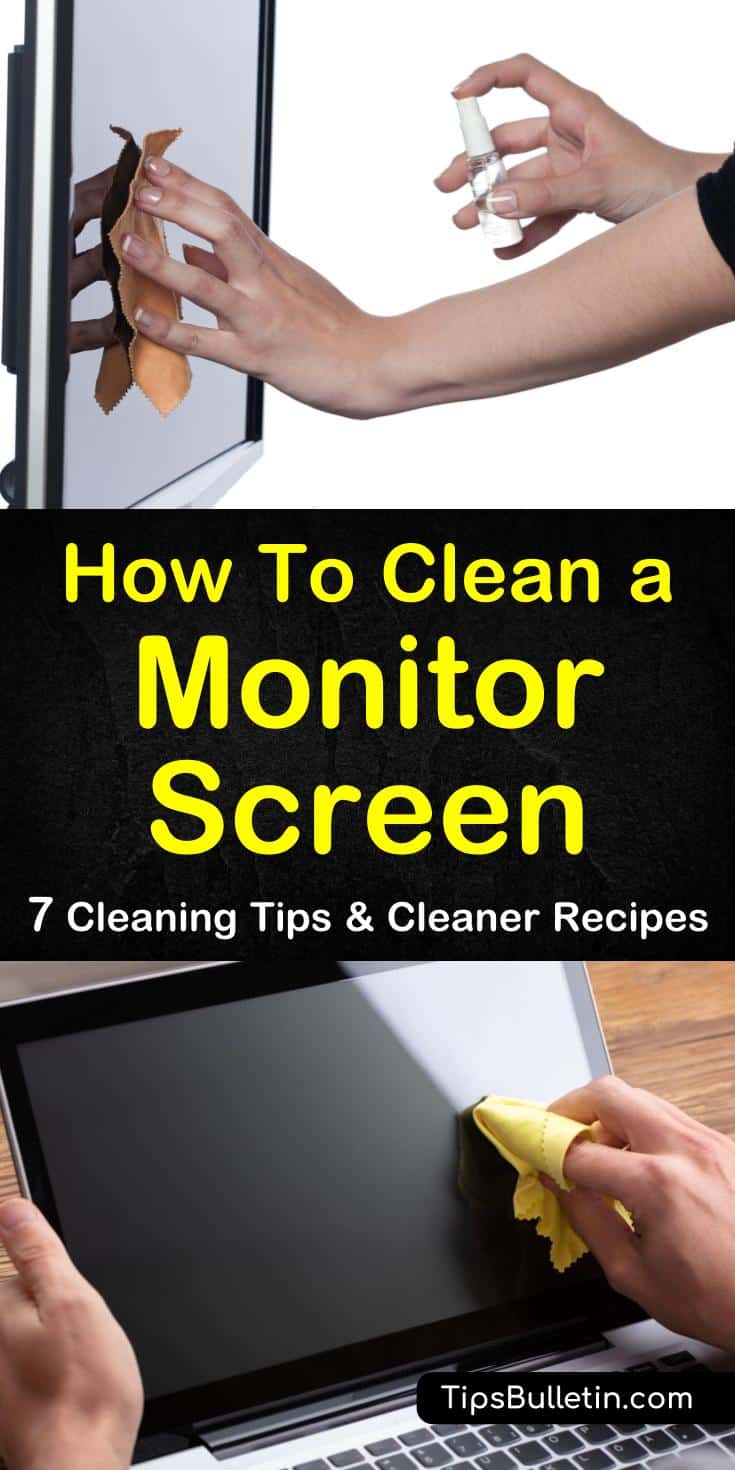Monitor screens are a lot like eyeglasses: we take them for granted until they get dirty or scratched. To keep your home office in tip-top shape, you need to know how to clean a monitor screen quickly and thoroughly. Having to work with a computer monitor covered in grime is an unpleasant experience that can impact our entire day without us realizing it.
A dirty monitor can affect our productivity and health, and it makes every trip to the computer a bit less pleasant, while a clear LCD improves our experience. Our guide helps you find the information you need to get your monitor looking good and keeping it that way.
You’ll find out the best method for simple cleaning and will learn several fantastic monitor cleaner recipes along the way. And, we also show you how to complete your monitor cleaning by getting rid of the unsightly scratches on your screens. Your monitors and HDTV will look brand new!

The Best Way to Clean Computer Monitor Screens
We have several ideas for you to choose from when cleaning your monitor screens. While you’re at it, be sure to clean your mechanical keyboard at the same time so your computer will be ready to go when you need it.
Here’s How to Clean a Monitor Screen Quickly and Safely
To make sure that your screens always look their best, you need to have a tried-and-true strategy. Getting your LCD screens clean and happy requires a step-by-step process and knowledge that you’ll get the results you want every time you clean your monitors and laptops.
This section examines the standard monitor cleaning process and goes through each step to make sure you have all of the information you need.
We show you the best way to clean laptop screen frames so that they don’t scratch or smudge, and you’ll learn how to get your LCD screens clean using one of several different homemade cleaning solutions. And, you’ll find out which commercial cleaning kits are worth your time and money.
Clean Your Monitor Frame with Windex
Modern LCD screens that you find in Samsung and other name brand monitors, laptops, and HDTVs react badly to alcohol. Isopropyl alcohol, or rubbing alcohol, is the main ingredient in Windex and most other window cleaners.

Glass cleaner spray will melt LCD monitor screen coatings, so only use it on the bezel, which is the plastic frame surrounding the screen.
Always unplug the monitor before cleaning it. Spray glass cleaner on the fabric and never on the plastic itself, as you can easily damage the screen.
Wipe the damp cloth gently on the bezel, taking care not to touch the screen. Use toothpicks and cotton swabs to clean the crevices around buttons and other hard-to-reach areas.
Wipe Down the Monitor Screen with a Dry Cloth
How long your monitor lasts depends on how often you touch the screen. The less contact with your hands or caustic chemicals an LCD or CRT screen has, the longer it will last.
With that in mind, take care to keep contact with the screen to a minimum and always wipe it down with a dry, clean cloth before you apply any cleaning agents. Don’t use too much pressure as you wipe.
Never use paper towels or other scratchy products to wipe down a monitor, as you can leave small scratches that build up over time. Don the gloves to avoid getting oil from your skin on the monitor, and give the screen a blast with the compressed air to clear away any loose debris and to get the dust off the screen.
Wipe the screen with the cloth using gentle, circular motions. Replace the fabric whenever it collects too much dirt and grime.
Clean Your Screen with Distilled Water
A dry wipedown is the best first step when cleaning a computer monitor screen, but it often won’t do the entire cleaning job on its own. To get your monitor screen or iPad screen looking its best, you might need to break out a liquid cleaner.
Before you reach for something more powerful, though, give distilled water a try. Never clean with tap water, as you could leave mineral deposits behind.
Don the gloves. Dampen the cloth slightly in the water, and wipe the computer or TV screen in a gentle, circular motion. Don’t apply any liquid directly to the screen, as you can damage the electronics. When you have removed all dirt, use a second cloth to dry the screen without leaving smudges.
Get Your Monitor Screen Clean with Homemade Screen Cleaner
If you’ve tried cleaning monitors with distilled water and can’t get it looking good, you might have to kick things up several notches and make your own screen cleaner to effectively clean smudges or grease off your computer screen.
As we previously mentioned, neither ethyl alcohol nor rubbing alcohol are suitable for monitor screens, so we’ve included a fantastic monitor cleaning solution recipe that uses diluted vinegar to get your PC monitor screen looking gorgeous.
If you are looking for a simple and easy way to clean your dirty eyeglasses, this recipe will also work for that. A DIY glass cleaner with vinegar is not only easy to use but also effective and inexpensive. Glasses are highly susceptible to fingerprints and smudges that make it difficult to see.
This DIY glasses cleaner and computer monitor cleaner can be used on a multitude of surfaces in the home or office when you don’t have commercial products handy. Try it on windows or glass tabletops.
To clean flat screen TV without streaks or to rid your computer monitor of fingerprints, combine the distilled water and vinegar in the container, and spray the fabric until it is barely damp.
Carefully wipe the computer screen or TV with the damp cloth, making gentle, circular motions. Replace the cloth whenever it gets dirty to prevent streaking or making the problem worse.
Use Commercial Screen Wipes or a Cleaning Kit
If you have a stubborn stain sitting on your monitor that won’t go away after you’ve hit it with your homemade screen cleaning product, it’s time to get out the professional equipment. Commercially sold screen wipes and screen cleaning kits are perfect for the trickier cleaning jobs, and because they come with a guarantee, you should see results if you use them properly.
Always check the instructions before using commercial cleaning products. When you use wipes, avoid cleaning a single spot with a circular motion, as doing so can create a buffed out place on the screen.
Cleaning a Computer Monitor Screen – Removing Scratches
Getting the dirt off of your monitor or iPhone screen is only part of the battle. If you want a screen that looks as clean as the day you bought it, make sure that any marks or scratches get cleaned away along with the dirt.
Small scratches can dull your monitor’s display, and significant scratches can ruin it, so always clean away any scratches or dings whenever you clean your screens. This section gives you a couple of excellent options for removing monitor scratches.
We show you a surprising fix that requires nothing more than petroleum jelly and elbow grease, and you’ll also get a fantastic home remedy to buff away scratch marks that uses baking soda. Your monitors will be showroom perfect when you’re finished with them.
Hide Scratches with Petroleum Jelly
Many scratches are minor and don’t require a full repair job to keep them from impacting your experience. You can often mask small scratches with petroleum jelly.
While using petroleum jelly on your scuff marks won’t repair them, it will hide them and make them unobtrusive. Give this fix a go if you don’t have the time or gear to enact a more extensive repair.
Dip a cotton swab in petroleum jelly and apply it to the scratch. Use a gentle, back-and-forth motion to get the jelly in the scratch completely. Wipe away any excess with the cloth. Reapply the petroleum jelly if it wears off.
Repair Monitor Scratches with Baking Soda
Baking soda might seem like a strange bedfellow with computer screens, but a baking soda paste, when applied correctly, can work miracles on your LCD screens. Baking soda contains a gentle abrasive that buffs small scratches without digging too deeply into the surrounding plastic. Test this fix on a small spot before applying it to large areas.
Don the gloves. Combine the baking soda and the water in a small container, and dip the cloth in the mixture. Wipe the paste over the scratch, and allow it to dry. Wipe the area with a slightly damp cloth to clean away the paste.
We hope you had a great time reviewing our tips on the best way to clean computer screens. To get the most out of our phones, TVs, and computers, we need to keep our monitor screens looking their best.
That’s why it’s essential to know how to clean a monitor screen and why we developed this guide. Our article shows you the top ways of cleaning a computer monitor screen so your electronics look brand new.

Thanks for taking a look at our guide on how to clean a monitor screen. Were these monitor cleaning tips useful to you? If so, we’d love it if you’d share our tips on the way to clean computer monitor screens with your family and friends on Pinterest and Facebook.